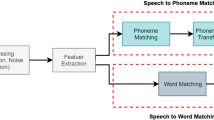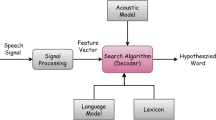Abstract
Automatic Speech Recognition systems that convert language into written text have greatly transformed human–machine interaction. Although these systems have achieved results, in languages building accurate and reliable ASR models for low resource languages like Gujarati comes with significant challenges. Gujarati lacks data and linguistic resources, making developing high-performance ASR systems quite difficult. In this paper, we propose an approach to enhance the effectiveness of a Gujarati ASR model despite resources. We achieve this by incorporating integrated features such as Mel Frequency Cepstral Coefficients (MFCC) and Gammatone Frequency Cepstral Coefficients (GFCC) utilizing the DeepSpeech2 architecture and implementing an improved spell correction technique based on the Bidirectional Encoder Representations from Transformers (BERT) algorithm. Our approach has demonstrated superiority over previous state-of-the-art methodologies through testing and evaluation. The experimental results demonstrate that our proposed method consistently reduces the Word Error Rate (WER) by 10–12 percentage points compared to the existing work, surpassing the most significant improvement of 5.87%. Our findings demonstrate the viability of developing accurate and dependable ASR systems for languages with limited resources, such as Gujarati.





Similar content being viewed by others
References
Amodei, D. et al. (2016). Deep Speech 2 : End-to-end speech recognition in English and Mandarin. In Proceedings of the 33rd international conference on machine learning, 2016, (vol. 48, pp. 173–182). Retrieved from https://proceedings.mlr.press/v48/amodei16.html
Anoop, C. S., & Ramakrishnan, A. G. (2021, July). CTC-based end-to-end ASR for the low resource Sanskrit language with spectrogram augmentation. In 2021 National conference on communications (NCC) (pp. 1–6). IEEE.
Bhogale, K., Raman, A., Javed, T., Doddapaneni, S., Kunchukuttan, A., Kumar, P., & Khapra, M. M. (2023, June). Effectiveness of mining audio and text pairs from public data for improving ASR systems for low-resource languages. In ICASSP 2023–2023 IEEE international conference on acoustics, speech and signal processing (ICASSP) (pp. 1–5). IEEE.
Billa, J. (2018). ISI ASR system for the low resource speech recognition challenge for Indian languages. In INTERSPEECH, 2018.
Cho, K., et al. (2014). Learning phrase representations using RNN encoder–decoder for statistical machine translation In: Proceedings of the 2014 conference on empirical methods in natural language processing (EMNLP), Oct 2014, pp. 1724–1734. https://doi.org/10.3115/v1/D14-1179.
Dave, D. (2015). An approach to increase word recognition accuracy in Gujarati language. International Journal of Innovative Research in Computer and Communication Engineering, 3, 6442–6450. https://doi.org/10.15680/ijircce.2015.0307012
Deshmukh, A. M. (2020). Comparison of hidden Markov model and recurrent neural network in automatic speech recognition. European Journal of Engineering and Technology Research, 5(8), 958–965. https://doi.org/10.24018/ejeng.2020.5.8.2077
Dua, M., Aggarwal, R. K., & Biswas, M. (2018). Discriminative training using noise robust integrated features and refined HMM modeling. Journal of Intelligent Systems, 29(1), 327–344.
Dua, M., Aggarwal, R. K., & Biswas, M. (2019). GFCC based discriminatively trained noise robust continuous ASR system for Hindi language. Journal of Ambient Intelligence and Humanized Computing, 10, 2301–2314.
Dubey, P., & Shah, B. (2022). Deep speech based end-to-end automated speech recognition (ASR) for Indian-English accents. arXiv preprint arXiv:2204.00977.
Forsberg, M. (2003). Why is speech recognition difficult.
Gaudani, H., & Patel, N. M. (2022). Comparative study of robust feature extraction techniques for ASR for limited resource Hindi language. In Proceedings of second international conference on sustainable expert systems: ICSES 2021 (pp. 763–775). Springer Nature.
Graves, A., & Jaitly, N. (2014). Towards end-to-end speech recognition with recurrent neural networks. In Proceedings of the 31st international conference on machine learning, 2014, (vol. 32, no. 2, pp. 1764–1772). Retrieved from https://proceedings.mlr.press/v32/graves14.html
Graves, A., et al. (2006). Connectionist temporal classification: Labelling unsegmented sequence data with recurrent neural networks. In Proceedings of the 23rd international conference on machine learning, 2006.
Hu, Y., Jing, X., Ko, Y. L., & Rayz, J. (2021). Misspelling correction with pre-trained contextual language model.
Joshi, B., Bhatta, B., Panday, S. P., & Maharjan, R. K. (2022). A novel deep learning based nepali speech recognition. In Innovations in electrical and electronic engineering: Proceedings of ICEEE 2022, (Vol. 2, pp. 433–443). Springer.
Krishna, H., Gurugubelli, K., Vegesna, V., & Vuppala, A. (2018). An exploration towards joint acoustic modeling for Indian languages: IIIT-h submission for low resource speech recognition challenge for Indian languages, INTERSPEECH 2018 (pp. 3192–3196). https://doi.org/10.21437/Interspeech.2018-1584.
Lakshminarayanan, V. (2022). Impact of noise in automatic speech recognition for low-resourced languages, Doctoral dissertation, Rochester Institute of Technology.
Maji, B., Swain, M., & Panda, R. (2022). A feature selection based parallelized CNN-BiGRU network for speech emotion recognition in Odia language.
Patel, D., & Goswami, M. (2014). Word level correction in Gujarati document using probabilistic approach. https://doi.org/10.1109/ICGCCEE.2014.6921395.
Raval, D., Pathak, V., Patel, M., & Bhatt, B. (2021). Improving deep learning based automatic speech recognition for Gujarati. ACM Transactions on Asian and Low-Resource Language and Information Processing. https://doi.org/10.1145/3483446
Scharenborg, O., Ciannella, F., Palaskar, S., Black, A., Metze, F., Ondel, L., & Hasegawa-Johnson, M. (2017). Building an ASR system for a low-resource language through the adaptation of a high-resource language ASR system: Preliminary results. In Proceedings of international conference on natural language, signal and speech processing (ICNLSSP) (pp. 26–30).
Schuster, M., & Paliwal, K. K. (1997). Bidirectional recurrent neural networks. IEEE Transactions on Signal Processing, 45(11), 2673–2681. https://doi.org/10.1109/78.650093
Srivastava, B., Abraham, B., Sitaram, S., Mehta, R., & Jyothi, P. (2019). End-to-end ASR for code-switched Hindi-English speech.
Sutskever, I., Vinyals, O., & Le, Q. V. (2014). Sequence to sequence learning with neural networks. In Advances in neural information processing systems, 2014 (Vol. 27). https://proceedings.neurips.cc/paper/2014/file/a14ac55a4f27472c5d894ec1c3c743d2Paper.pdf
Tailor, J. H., & Shah, D. B. (2018). HMM-based lightweight speech recognition system for Gujarati language.
Toshniwal, S., et al. (2017). Multilingual speech recognition with a single end-to-end model.
Zhang, S., Huang, H., Liu, J., & Li, H. (2020). Spelling error correction with soft-masked BERT.
Author information
Authors and Affiliations
Corresponding author
Ethics declarations
Conflict of interest
I, Mohit Dua, on the behalf of all the authors declare that: this study did not receive any finding from any resource, all the authors and the submitted manuscript do not have any conflict of interest and this article does not contain any studies with human participants or animal performed by any of the authors.
Additional information
Publisher's Note
Springer Nature remains neutral with regard to jurisdictional claims in published maps and institutional affiliations.
Rights and permissions
Springer Nature or its licensor (e.g. a society or other partner) holds exclusive rights to this article under a publishing agreement with the author(s) or other rightsholder(s); author self-archiving of the accepted manuscript version of this article is solely governed by the terms of such publishing agreement and applicable law.
About this article
Cite this article
Dua, M., Bhagat, B. & Dua, S. An amalgamation of integrated features with DeepSpeech2 architecture and improved spell corrector for improving Gujarati language ASR system. Int J Speech Technol (2024). https://doi.org/10.1007/s10772-024-10082-z
Received:
Accepted:
Published:
DOI: https://doi.org/10.1007/s10772-024-10082-z




